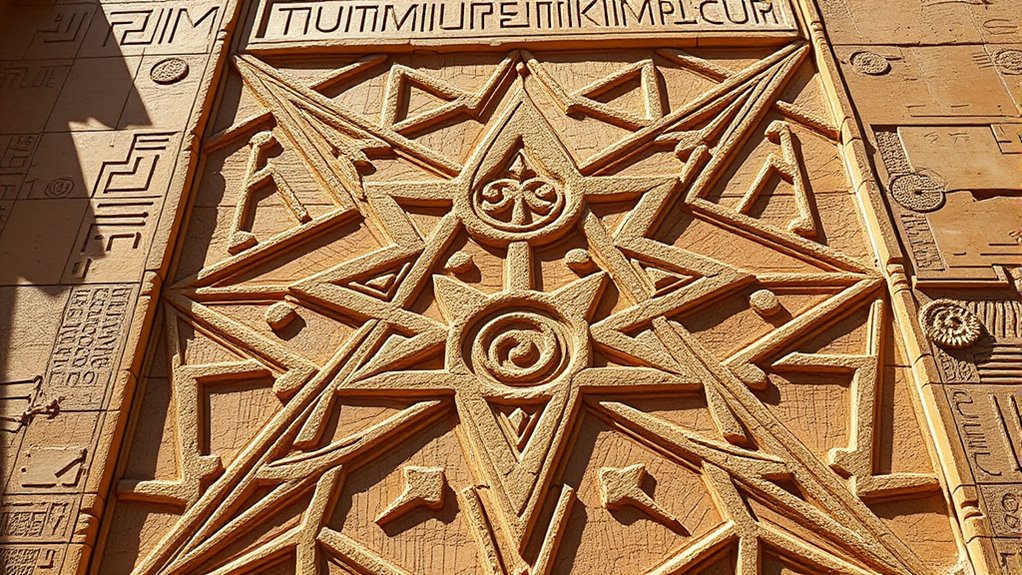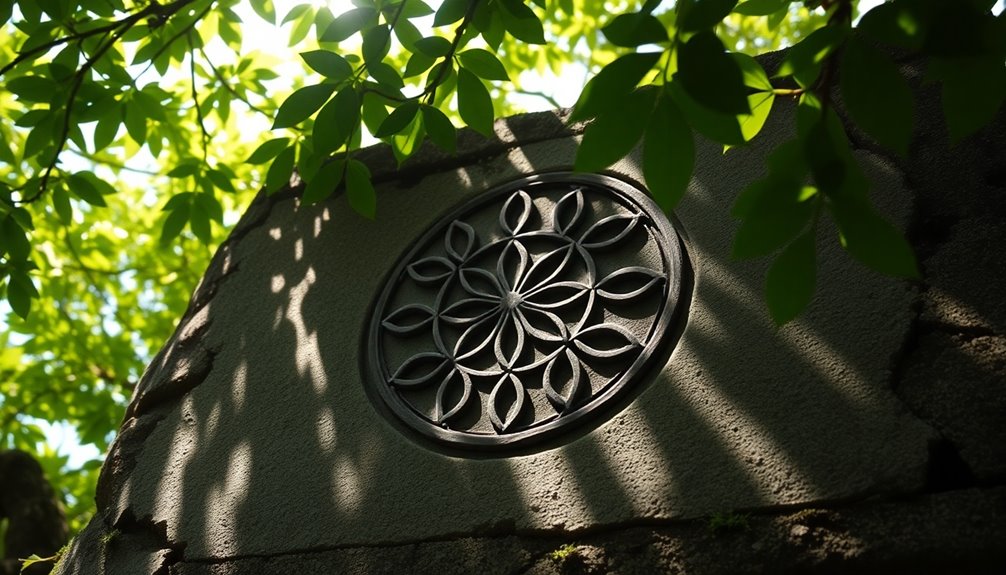Ancient Egyptian architecture reflects sacred geometry through precise proportions, symbolic numerology, and celestial alignments. You’ll notice how structures embody cosmic harmony by following geometric patterns that symbolize divine principles. The use of numbers like 3 and 7 reinforces spiritual meanings, while alignment with celestial bodies links architecture to the universe’s divine order. If you look closer, you’ll uncover how these sacred geometrical principles create harmony between the human and divine domains.
Key Takeaways
- Ancient Egyptian architecture employs geometric shapes and proportions to embody cosmic harmony and spiritual principles.
- Numerical symbolism, such as the significance of the number 3, guides temple and tomb layouts.
- Structures are designed with precise geometric ratios, like the golden ratio, to reflect divine order.
- Sacred symmetry in Egyptian architecture creates portals between human and divine realms.
- Celestial alignments of temples and pyramids mirror cosmic harmony and facilitate divine communication.

Ancient Egyptian architecture showcases a profound mastery of sacred geometry, reflecting their deep spiritual beliefs and understanding of the universe. As you explore their structures, you’ll notice how numerical symbolism plays a vital role in their design. Numbers like 2, 3, 4, and 7 are not arbitrary; they carry spiritual significance and are woven into the very fabric of their monuments. For example, the use of the number 3 often symbolizes harmony and balance, seen in the tripartite divisions of temples or the tripartite nature of gods. These numerical symbols aren’t just decorative—they serve as a blueprint for conveying divine truths, ensuring that each structure aligns with cosmic principles. Moreover, the Egyptians believed that specific geometric shapes and proportions embodied cosmic harmony, which guided their architectural choices. You’ll also observe that geometric proportions form the backbone of Egyptian architectural precision. They believed that harmony in proportions reflected cosmic order, and they meticulously calculated dimensions to embody this philosophy. The ratio of height to width, for instance, often adheres to specific geometric proportions that create a sense of stability and sacred balance. This isn’t accidental; it’s a deliberate effort to mirror the universe’s divine structure. The Great Pyramid of Giza is a prime example, where the precise proportions symbolize the connection between the earthly and divine domains. Its dimensions follow specific ratios believed to correspond with the golden ratio, which Egyptians considered a fundamental element of divine harmony.
In addition to ratios, the layout of temples and tombs often follows geometric patterns that emphasize sacred symmetry. These patterns aren’t just aesthetically pleasing—they encode spiritual concepts and serve as physical manifestations of sacred geometry. You’ll find that the symmetry in their architecture isn’t purely for visual appeal but is intended to create a portal between the human and divine worlds. The alignment of structures with celestial bodies further underscores their reliance on geometric proportions and numerical symbolism, as they believed that aligning their sacred spaces with the cosmos would facilitate divine communication.
Frequently Asked Questions
How Did Ancient Egyptians Acquire Knowledge of Sacred Geometry?
You learn that ancient Egyptians acquired their knowledge of sacred geometry through an apprenticeship system, where master builders mentored apprentices in architecture and mathematics. They studied architectural inscriptions that recorded geometric principles and measurements used in construction. This hands-on approach, combined with oral traditions and practical experience, allowed them to master sacred geometry, which they applied to create precise, harmonious structures like pyramids and temples that reflected their spiritual beliefs.
Are There Specific Sacred Symbols Associated With Egyptian Architecture?
You’ll notice that Egyptian architecture incorporates specific sacred symbols, like hieroglyphic symbolism, which reflect spiritual beliefs. These symbols guide ritualistic construction, ensuring each structure aligns with divine principles. When building temples and pyramids, Egyptians used these symbols to embed spiritual meaning and purpose. By understanding hieroglyphic symbolism, you can see how sacred geometry and symbolism intertwine, creating spaces that embody cosmic order and religious significance.
Did Sacred Geometry Influence Other Ancient Civilizations?
You might think sacred geometry stayed isolated in Egypt, but it actually influenced many ancient civilizations through intercultural influences. Ironically, today, we still use these ancient principles in modern applications like architecture and design. Sacred geometry’s timeless appeal proves it’s more than a relic; it’s a universal language that bridges cultures and continues to shape our world, revealing that ancient wisdom still guides us in unexpected ways.
What Tools Did Egyptians Use to Achieve Geometric Precision?
You use ancient measuring tools like cords with knots and simple plumb bobs to achieve geometric precision. The Egyptians relied on geometric construction techniques such as dividing lines into equal parts and creating right angles with tools like the set square. These methods helped them accurately design and build their structures, ensuring that their architecture reflected their advanced understanding of sacred geometry.
Is There Any Link Between Sacred Geometry and Egyptian Spiritual Beliefs?
You’ll find that sacred geometry is deeply linked to Egyptian spiritual beliefs, emphasizing cosmic harmony and spiritual symbolism. About 80% of Egyptian temples incorporate geometric ratios that reflect the universe’s order. This connection shows how they believed geometry expressed divine principles, helping to align their structures with cosmic forces. By understanding these patterns, you see how their architecture wasn’t just functional but also a reflection of their spiritual worldview.
Conclusion
So, next time you marvel at Egypt’s grand monuments, remember it’s all thanks to sacred geometry—because nothing says “divine” like perfect ratios and mystical shapes. Who knew that ancient architects spent centuries obsessing over circles and triangles instead of, say, inventing Wi-Fi? But hey, their obsession with cosmic harmony gave us timeless wonders, proving that perhaps, geometry really is the secret to eternal fame—just don’t forget to thank the stars (and some pretty precise calculations).










